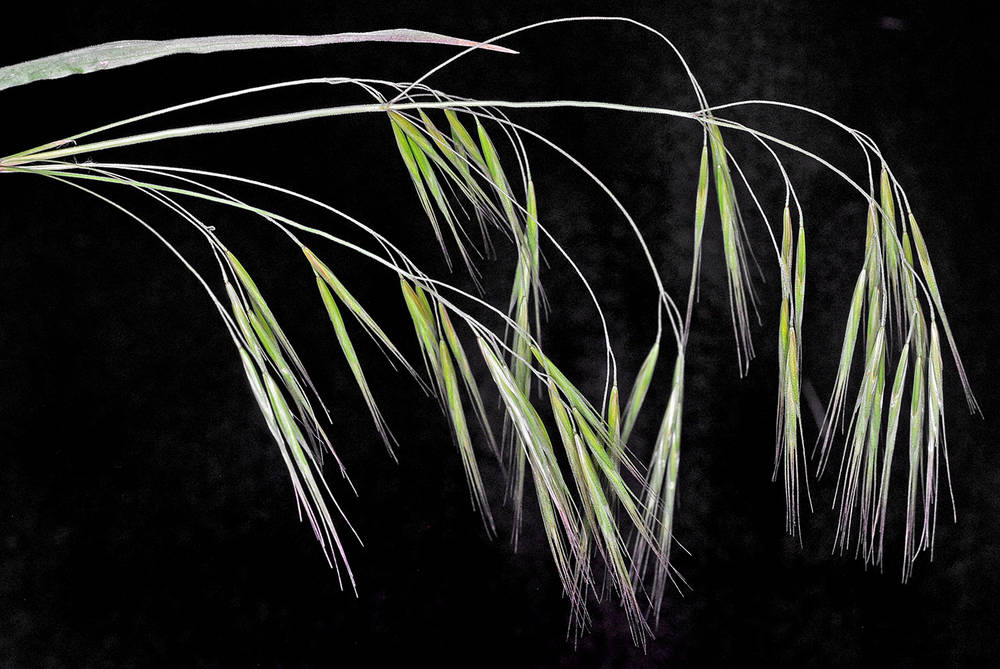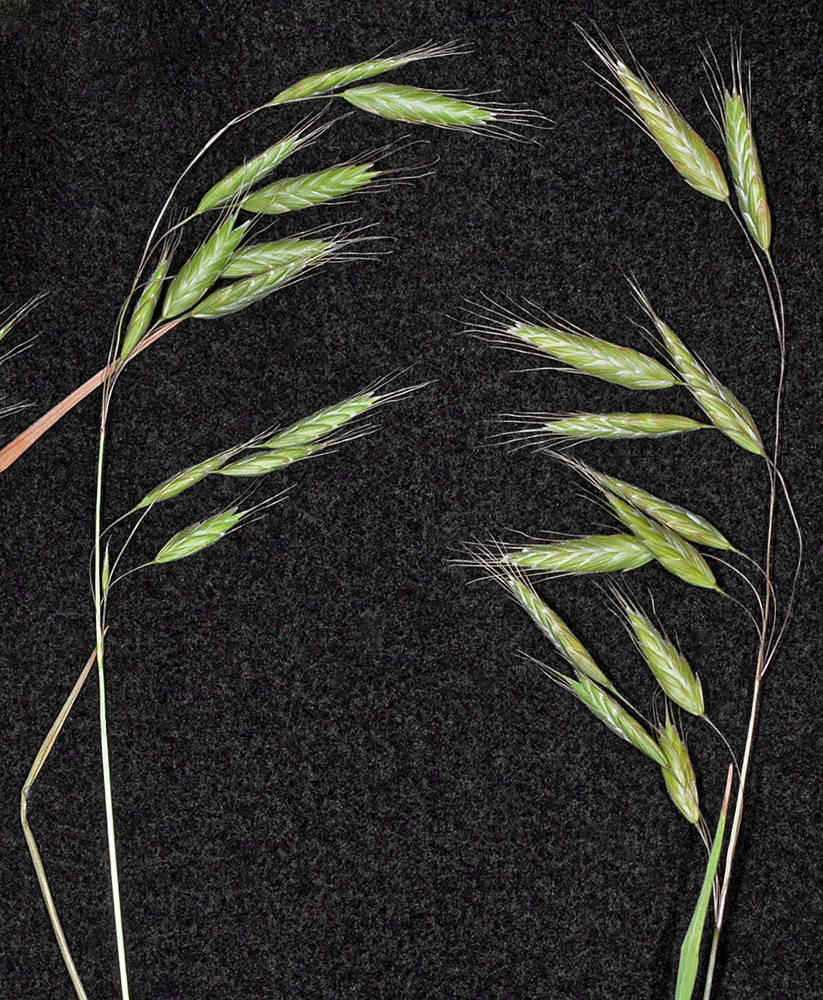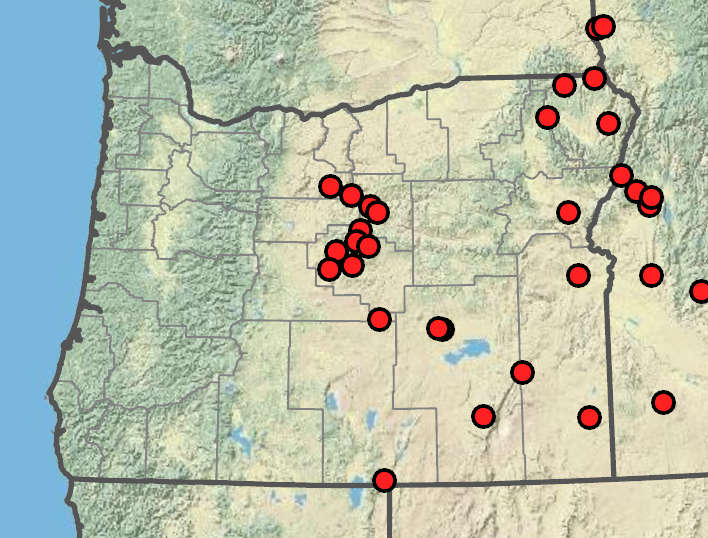Bromus tectorum
Bromus squarrosus
cheatgrass, downy brome, downy chess
squarrose brome
puberulent.
sheaths densely and softly retrorsely pubescent to pilose; upper sheaths sometimes glabrous;
blades 1–16 cm × 1–6 mm, softly hairy on both surfaces.
lower sheaths densely pilose; upper sheaths glabrous;
blades 5–15 cm × 4–6 mm, densely pilose on both surfaces.
5–20 × 3–8 cm; open, nodding;
branches 1–4 cm, drooping, 1-sided and longer than the spikelets, usually at least 1 branch with 4–8 spikelets.
7–20 × 4–8 cm; open, nodding, often with few spikelets, usually 1-sided;
branches sometimes longer than the spikelets, ascending-spreading, flexuous, slightly curved.
10–20 mm, moderately laterally compressed, not densely crowded, 4–8 florets.
15–30 mm, lanceolate to elliptic; terete to moderately laterally compressed, 8–30 florets;
floret bases concealed at maturity;
rachilla internodes concealed at maturity.
villous, pubescent, or glabrous;
lower glumes 4–9 mm, 1-veined;
upper glumes 7–13 mm, 3–5-veined.
smooth, scabrous, or densely hairy;
hairs to 0.8 mm;
lower glumes 4.5–7 mm, 3–5(7)-veined;
upper glumes 6–8 mm, 7-veined.
as long as the paleas; thin, weakly inrolled or flat.
9–12 mm, lanceolate, glabrous or pubescent to pilose, 5–7-veined;
tips acuminate; hyaline; bifid, with teeth 0.8–2(3)mm, awned;
lemma awns 10–18 mm; straight.
8–11 × 2–2.4 mm, lanceolate, chartaceous; smooth, scabridulous, or densely pubescent with hairs to 0.8 mm, 7–9-veined;
margins hyaline, 0.6–0.9 mm wide, strongly angled above the middle, not inrolled at maturity;
veins not raised and thickened;
tips rounded to acute; bifid;
teeth shorter than 1 mm;
lemma awns 8–10 mm, flattened and sometimes twisted at the base, spreading at maturity, arising 1.5 mm or more below the lemma tips.
0.5–1 mm.
0.8–1.3 mm.
=14.
=14.
Bromus tectorum
Bromus squarrosus
Disturbed areas, sagebrush steppe, degraded grasslands, roadsides. 0–2400 m. BR, BW, Casc, Col, CR, ECas, Lava, Owy, Sisk, WV. CA, ID, NV, WA; throughout North America; worldwide. Exotic.
Bromus tectorum is a relatively short grass with drooping inflorescences. Similar B. sterilis and B. diandrus have longer glumes, lemmas, and awns, and spikelets that hang down at a shallower angle than those of B. tectorum. The introduction of B. tectorum to shrub steppe habitats during a time of massive overgrazing in the late 1800s has made restoration of native plant communities difficult or impossible, even where grazing no longer occurs. Fast-growing B. tectorum seedlings outcompete slower growing native grass seedlings for water in drying soils. At maturity, the awns make B. tectorum unpalatable to livestock.
Dry, disturbed areas, roadsides. 500–1900m. BR, BW, Lava. CA, ID, NV, WA; scattered throughout Canada and US; southern Europe, central Russia. Exotic.
Bromus squarrosus is an uncommon annual with few long, dangling spikelets. Its lemma margins are relatively strongly angled above the middle, with broad hyaline edges. It is most likely to be confused with B. japonicus, which has narrower hyaline lemma margins and shorter spikelets with fewer florets.
Barbara Wilson, Richard Brainerd, Nick Otting
Barbara Wilson, Richard Brainerd, Nick Otting
- Local floras:
BC,
CA,
OR,
WA
- Local Web sites:
CalFlora,
CalPhotos,
Flora NW,
PNW Herbaria
WildflowerSearch
iNaturalist (observations)
USDA Plants Database
- LBJ Wildflower Center
- SEINet
- Plants of the World Online
- Encyclopedia of Life
- Wikipedia
- Google Image Search
- Local floras:
BC,
OR,
WA
- Local Web sites:
Flora NW,
PNW Herbaria
WildflowerSearch
iNaturalist (observations)
USDA Plants Database
- LBJ Wildflower Center
- SEINet
- Plants of the World Online
- Encyclopedia of Life
- Wikipedia
- Google Image Search





